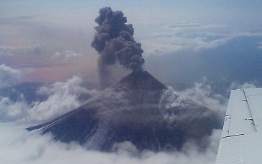Plate Boundaries and VolcanoesLooking at a map of
lithospheric plate boundaries shows volcanic activity along the
boundaries of some lithospheric plates. Convergent plate boundaries where subduction occurs
commonly experience volcanic activity
Volcanoes are also found along spreading plate boundaries. Here, basaltic magma is extruded onto the floor of the ocean. In some places, the magma solidifies into great volcanic cones rising from the ocean floor. Iceland's Heimaey volcano is a good example of volcanic activity along the midocean ridge. One of the most well-known locations for volcanic activity, the Hawaiian Islands, is not a product of plate margin processes. The Hawaiian Islands have formed over a "hot spot" or mantle plume where magma rises to the surface and flows out onto the ocean floor. The chain of islands were created as the Pacific Plate moves over the mantle plume creating a succession of volcanoes oriented in a northwest (oldest) to southeast direction (youngest).
Assess your basic understanding of the preceding material by "Looking Back at Plate Tectonics and Boundaries" or continue reading. |
 Figure 15.22 Shishaldin Volcano, Alaska is a volcano found on the
"Ring of Fire" (Source: Volcano Hazards Program, USGS Used
with permission)
Figure 15.22 Shishaldin Volcano, Alaska is a volcano found on the
"Ring of Fire" (Source: Volcano Hazards Program, USGS Used
with permission)